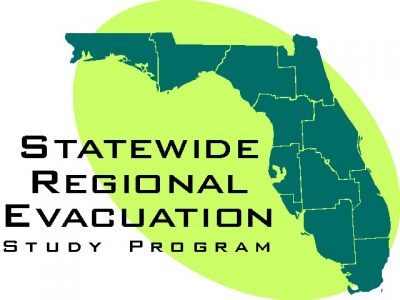
In 2004 and 2005, Florida experienced an unprecedented level of tropical storm activity. In 2004, Hurricanes Charley, Frances, Ivan and Jeanne impacted our State. Hurricanes Dennis, Katrina, Rita and Wilma came ashore in Florida in 2005. In the short span of 24 months, millions of Florida residents were impacted, and property damages ran into the billions of dollars.
In response to these devastating hurricane seasons, state legislators passed House Bill 1721 and House Bill 1359, which identified enhanced statewide hurricane evacuation planning and a redefinition of the coastal high hazard area as state priorities. In accordance with this legislative direction, the State of Florida Division of Emergency Management (DEM) obtained grant money through the Federal Emergency Management Agency’s (FEMA) Hazard Mitigation Grant Program to conduct regional evacuation studies across the State.
DEM contracted with Florida’s Regional Planning Councils to carry out the Statewide Regional Evacuation Study Program (SRESP), in close collaboration with county emergency management agencies. The Regional Planning Councils facilitated consistent and integrated mapping and analysis of all-hazards evacuation across Florida. In South Florida, this multi-year project resulted in a comprehensive regional evacuation study that encompasses Miami-Dade, Broward and Monroe counties and is integrated with similar work completed by the Regional Planning Councils to the north (Treasure Coast) and west (Southwest Florida). Inter-agency cooperation and data sharing was a vital part of ensuring the success of this regional and state initiative. A regional Technical Advisory Team of county-level agencies was created, with each county’s Emergency Management Agency acting as the lead.
Although hurricanes are a prominent concern in the studies, the framework was established for an “all hazards” analysis in order to support planning efforts to prepare for other types of evacuations as well, such as inland flooding or wildfires. These studies are not policy documents – instead, they are intended to provide support for future updates to local government emergency management plans. The completed study consists of 88 volumes of material (8 for each of the 11 regions across the state).
As part of the statewide study, the DEM managed a separate contract for the production of updated Light Detection and Ranging (LiDAR) elevation data, which was completed for about 28,000 square miles across the State of Florida. CH2M Hill was the contractor that collected data for South Florida. Processing of the LiDAR data and preparation of the data for the National Oceanic and Atmospheric Administration’s National Hurricane Center (NHC) was completed in May 2009. New Sea, Lake and Overland Surge from Hurricanes (SLOSH) modeling was then completed for two SLOSH basins involved in the update for South Florida: Biscayne Bay for Miami-Dade and Broward Counties, and Florida Bay for Monroe County. Additional information about the LiDAR and SLOSH project is available on the Florida Division of Emergency Management website at www.floridadisaster.org/gis/lidar.
During the preparation of the Study, which began in December 2006, several of the Councils were designated as leads for development of the methodology for specific sections of the studies. South Florida Regional Planning Council staff was the lead for the demographic analysis. In that role, Council staff developed a set of guidelines for the collection of data for demographic profiles for each county and each region, as well as for the collection of small-area data to support the transportation analysis. In addition, Council staff prepared demographic data for all 67 counties in the State of Florida, organized by RPCs, from the 2000 Census (block group data) and from the 2006 American Community Survey (ACS) (county data), to support the development of demographic profiles. Council staff also provided data from the 2000 Census Transportation Planning Package for 31 counties, with over ten thousand traffic analysis zones (TAZs), for use in the transportation analysis.
On December 15, 2010, the South Florida Regional Planning Council convened State and county emergency management and growth management officials at its Hollywood office to deliver the South Florida component of the SRESP. With the completion of the South Florida Regional Evacuation Study, county emergency management officials will have an opportunity to begin updating county emergency plans for operational purposes.
The completed study for South Florida consists of eight volumes, described below, with links for downloading the published documents. Please note, some of the documents are very large, as they contain maps and other figures. The ninth volume (Depth Analysis Atlas) was completed in May 2012.
For additional information related to the Statewide Regional Evacuation Study Program please contact sfadmin@sfrpc.com.
